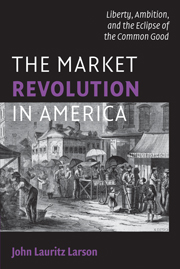Book contents
- Frontmatter
- Contents
- Acknowledgments
- Introduction: What Do We Mean by a Market Revolution in America?
- 1 First Fruits of Independence
- Interlude: Panic! 1819
- 2 Marvelous Improvements Everywhere
- Interlude: Panic! 1837
- 3 Heartless Markets, Heartless Men
- 4 How Can We Explain It?
- Epilogue: Panic! 2008, Déjà vu All over Again
- An Essay on the Sources
- Index
3 - Heartless Markets, Heartless Men
Published online by Cambridge University Press: 05 June 2012
- Frontmatter
- Contents
- Acknowledgments
- Introduction: What Do We Mean by a Market Revolution in America?
- 1 First Fruits of Independence
- Interlude: Panic! 1819
- 2 Marvelous Improvements Everywhere
- Interlude: Panic! 1837
- 3 Heartless Markets, Heartless Men
- 4 How Can We Explain It?
- Epilogue: Panic! 2008, Déjà vu All over Again
- An Essay on the Sources
- Index
Summary
Much of what people experienced with the rise of capitalist market relations derived from the depersonalization of transactions – from the rise of heartless markets and heartless men. In the pre-modern world, who you were had everything to do with how you were treated in public places: whether you received credit, merited trust, deserved poor relief, or belonged in a circle of “friendship.” It was a hallmark of modern capitalist relations that transactions among individuals became routinized, institutionalized, and depersonalized, so that one could do business with strangers at a distance as readily as at home. In ways never intended (and largely unimagined at the time), the story of “marvelous improvements,” discussed previously, radically transformed the social relations that early Americans once had assumed to be natural, desirable, and perhaps even immutable. The same developments that sustained enthusiastic narratives of prosperity and progress turned up in counternarratives of loss, frustration, and dislocation. Individuals seized opportunities for gain and advancement that embroiled them forever in market relations that undermined their places of comfort in earlier networks of family, community, and friendship. The maddening ambivalence of the experience of the market revolution in antebellum America lies not just in the existence of counternarratives but their coexistence with the narratives of progress, often running side by side, like unnatural harmonies, in the lives of individuals who could not reconcile their contradictions.
- Type
- Chapter
- Information
- The Market Revolution in AmericaLiberty, Ambition, and the Eclipse of the Common Good, pp. 98 - 140Publisher: Cambridge University PressPrint publication year: 2009



